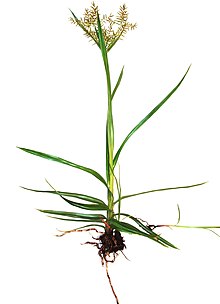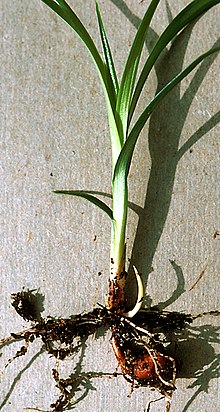Cyperus esculentus
| Chufa sedge | |
|---|---|

| |
| Scientific classification | |
| Kingdom: | Plantae |
| Clade: | Tracheophytes |
| Clade: | Angiosperms |
| Clade: | Monocots |
| Clade: | Commelinids |
| Order: | Poales |
| Family: | Cyperaceae |
| Genus: | Cyperus |
| Species: | C. esculentus
|
| Binomial name | |
| Cyperus esculentus | |
| Synonyms[2] | |
|
Synonymy
| |
Cyperus esculentus (also called chufa,
Cyperus esculentus can be found wild, as a weed, or as a crop. It is an invasive species outside its native range, and is readily transported accidentally to become invasive. In many countries, C. esculentus is considered a weed.[12][14] It is often found in wet soils such as rice paddies and peanut farms as well as well-irrigated lawns and golf courses during warm weather.
Description

Cyperus esculentus is an
The tubers are 0.3–2.5 cm (1⁄8–1 in) in diameter and the colors vary between yellow, brown, and black.
Similar species
- Sedges(Cyperus) have grass-like leaves and resemble each other in the appearance. They can mainly be distinguished from grasses by their triangular stems.
- Purple nutsedge (C. rotundus) is another weedy sedge that is similar to the yellow nutsedge (C. esculentus). These two sedges are difficult to distinguish from each other and can be found growing on the same site. Some differences are the purple spikelets and the tubers formed by C. rotundus are often multiple instead of just one at the tip. In addition the tubers have a bitter taste instead of the mild almond-like flavour of C. esculentus.[18]
Ecology
Cyperus esculentus is a highly invasive species in Oceania, Mexico, some regions of the United States, and the Caribbean, mainly by seed dispersion.[12] It is readily transported internationally, and is adaptable to re-establish in varied climate and soil environments.[12] In Japan, it is an exotic clonal weed favorable to establish in wet habitats.[12] Cyperus esculentus serves as a larval host for Euphyes vestris (dun skipper)[21] and
Cultivation
Cyperus esculentus is cultivated in

Climate requirements
Cyperus esculentus cultivation requires a mild climate. Low temperature, shade, and light intensity can inhibit flowering.[18] Tuber initiation is inhibited by high levels of nitrogen, long photoperiods, and high levels of gibberellic acid. Flower initiation occurs under photoperiods of 12 to 14 hours per day.
Soil requirements
Tubers can develop in soil depths around 30 cm, but most occur in the top or upper part. They tolerate many adverse soil conditions including periods of drought and flooding and survive soil temperatures around −5 °C (23 °F). They grow best on sandy, moist soils at a pH between 5.0 – 7.5.[18] The densest populations of C. esculentus are often found in low-lying wetlands.[24] They do not tolerate salinity.[18]
Cultivation process
Cyperus esculentus is normally planted on previously tilled flat soils with ridges to facilitate irrigation. Seeds are planted manually on these ridges, which are approximately 60 cm (2 ft) apart. Distances between seeds may vary from 15 to 20 cm (6 to 8 in) and seeding depth is around 8 cm (3 in). A typical seeding rate for chufa is about 120 kg of tubers/ha (107 lbs/acre).[25]
They are planted between April and May and must be irrigated every week until they are harvested in November and December. Tubers develop about 6–8 weeks after seedling emergence and grow quickly during July and August. The maturing is around 90–110 days. The average yield can approach between 10 and 19 t/ha.[26][27]
Compatibility with other crops

Cyperus esculentus is extremely difficult to remove completely once established. This is due to the plant having a stratified and layered root system, with tubers and roots being interconnected to a depth of 36 cm or more.
Harvest and drying process
Harvest usually occurs in November or December and the leaves are scorched during the harvest. With a combine harvester, the tiger nut is pulled out of the ground. Immediately after harvesting, the tiger nuts are washed with water in order to remove sand and small stones. The drying occurs usually in the sun and can take up to three months.[28] The temperatures and humidity levels have to be monitored very carefully during this period. The tiger nuts have to be turned every day to ensure uniform drying. The drying process ensures a longer shelf life. This prevents rot or other bacterial infections, securing quality and high nutrition levels. Disadvantages in the drying process are shrinkage, skin wrinkles and hard nut texture.[citation needed]
Storage
Tiger nut loses a considerable amount of water during drying and storage. The starch content of the tiger nut tubers decreases and the reducing sugar (invert sugar) content increases during storage.[29] Tiger nut can be stored dry and rehydrated by soaking without losing the crisp texture. Soaking is often done overnight. Dried tiger nuts have a hard texture and soaking is required to render them more easily edible and to ensure acceptable sensory quality.[18]
According to the Consejo Regulador de Chufa de Valencia (Regulating Council for Valencia's Tiger Nuts),[30] the nutritional composition/100 ml of the Spanish beverage horchata de chufas is as follows: energy content around 66 kcal, proteins around 0.5 g, carbohydrates over 10 g with starch at least 1.9 g, fats at least 2 g.
Uses
Dried tiger nut has a smooth, tender, sweet, and nutty taste. It can be consumed raw, roasted, dried, baked or as tiger nut milk, tiger nut drink or oil.
Drink
In Spain, the drink now known as horchata de chufa (also sometimes called horchata de chufas or, in West African countries such as Nigeria and Mali, kunun aya) is the original form of horchata.[dubious ] It is made from soaked, ground and sweetened tiger nuts mixed with sugar and water.[31] It remains popular in Spain, where a regulating council exists to ensure the quality and traceability of the product in relation to the designation of origin. There it is served ice-cold as a natural refreshment in the summer, often served with fartons. The majority of the Spanish tiger nut crop is utilised in the production of horchata de chufa. Alboraya is the most important production centre.
The tubers can be roasted and ground into a coffee substitute.[32]
Food

The tubers are edible raw or cooked.[33] They have a slightly sweet, nutty flavour, compared to the more bitter-tasting tuber of the related Cyperus rotundus (purple nutsedge). They are quite hard and are generally soaked in water before they can be eaten, making them much softer and giving them a better texture. They are a popular snack in West Africa. The tubers can also be dried and ground into flour.[33]
In
In Egypt, tiger nuts are known by the name Hab el-Aziz and after softening it by soaking in water, it is sold on hand carts as a street food.[34] Its popularity was depicted in movies, such as the song named after it, "Hab el Aziz".
Flour of roasted tiger nut is sometimes added to biscuits and other bakery products as well as in making oil, soap, and starch extracts. It is also used for the production of nougat, jam, beer, and as a flavoring agent in ice cream and in the preparation of kunu (a local beverage in Nigeria).[citation needed] Kunu is a nonalcoholic beverage prepared mainly from cereals (such as millet or sorghum) by heating and mixing with spices (dandelion, alligator pepper, ginger, licorice) and sugar. To make up for the poor nutritional value of kunu prepared from cereals, tiger nut was found to be a good substitute for cereal grains. Tiger nut oil can be used naturally with salads or for deep frying. It is considered to be a high-quality oil. Tiger nut “milk” has been tried as an alternative source of milk in fermented products, such as yogurt production, and other fermented products common in some African countries and can thus be useful replacing milk in the diet of people intolerant to lactose to a certain extent.[14]
Oil
Since the tubers of C. esculentus contain 20-36% oil, it has been suggested as potential oil crop for the production of biodiesel.[35] One study found that chufa produced 1.5 metric tonnes of oil per hectare (174 gallons/acre) based on a tuber yield of 5.67 t/ha and an oil content of 26.4%.[36] A similar 6-year study found tuber yields ranging from 4.02 to 6.75 t/ha, with an average oil content of 26.5% and an average oil yield of 1.47 t/ha.[37] The oil of the tuber was found to contain 18% saturated (palmitic acid and stearic acid) and 82% unsaturated (oleic acid and linoleic acid) fatty acids.[35]
Fishing bait
The boiled nuts are used in the UK as a bait for
History
It has been suggested that the extinct
Cyperus esculentus was one of the oldest cultivated plants in prehistoric and
References
- . Retrieved 25 November 2022.
- ^ "Cyperus esculentus L. — The Plant List". www.theplantlist.org. Archived from the original on 2020-06-01. Retrieved 2014-02-08.
- ^ "Chufa Information". Seed World. Retrieved 2020-04-29.
- ^ Chen, Angus (April 27, 2016). "Loathed By Farmers, Loved By Ancients: The Strange History of Tiger Nuts". NPR. Retrieved January 5, 2021.
- ^ "Is Atadwe (Tiger Nuts) Good for You? Health Benefits of Tiger Nuts". GhanaStar. 2015-11-15. Retrieved 2020-04-29.
- ^ "Yellow nutsedge". University of Maryland Extension. Retrieved January 5, 2021.[permanent dead link]
- ^ "Chufa (Earth Almond)". Chest of Books. Retrieved January 5, 2021.
- ISSN 1541-4337.
- ^ "World Checklist of Selected Plant Families: Royal Botanic Gardens, Kew". Kew Science. Archived from the original on April 5, 2011. Retrieved January 5, 2021.
- ^ "Biota of North America Program, 2013 county distribution map". Archived from the original on 2014-08-08. Retrieved 2014-07-24.
- ^ Altervista Flora Italiana, Zigolo dolce, Yellow Nutsedge, Cyperus esculentus L. Archived 2014-07-21 at the Wayback Machine includes photographs plus distribution maps for Europe and North America
- ^ a b c d e "Cyperus esculentus (yellow nutsedge)". CABI. 19 November 2018. Archived from the original on 2 May 2019. Retrieved 31 October 2019.
- ^ Nazish, Noma. "What Are Tiger Nuts And Why Should You Eat Them?". Forbes. Retrieved 2022-01-17.
- ^ .
- ^ a b Stoller, E.W. (1981). Yellow Nut Sedge: A Menace in the Corn Belt (No. 1642). US Department of Agriculture, Agricultural Research Service.
- S2CID 45148808.
- PMID 27110354.
- ^ a b c d e f g ^ USGS Weeds in the West project: Status of introduced Plants in Southern Arizona Parks, Factsheets for Cyperus esculentus L., 2003, Tucson, Arizona
- )
- S2CID 83193492.
- ^ "Cyperus esculentus". plants.ces.ncsu.edu. Retrieved 19 December 2023.
- ^ "Yellow Nutsedge Moth". www.butterfliesandmoths.org. Retrieved 22 January 2024.
- ^ "A molecular survey concerning the origin of Cyperus esculentus (Cyperaceae, Poales): two sides of the same coin (weed vs. crop)". Annals of Botany. 115 (5): 733–745. 2015. Retrieved 22 January 2024.
- ISBN 978-0135028148.
- ^ N. Pascual-Seva, et al., Furrow-irrigated chufa crops in Valencia (Spain) Spanish Journal of Agricultural Research 2013 11(1), 258-267. http://revistas.inia.es/index.php/sjar/article/view/3385/1803
- ^ Pascual-Seva, N., San Bautista, A., López Galarza, S., Maroto, J.V. and Pascual, B. 2012. Yield and Irrigation Water Use Efficiency for Ridge - and Bed - cultivated Chufa (Cyperus Esculentus L. var. Sativus Boeck). Acta Hort. (ISHS) 936:125-132
- ^ Reid WS, Hergert GB, Fagan WE, 1972. Development of a Prototype mechanical Harvester for Chufa (Cyperus esculentus L. var sativus Boek). Canadian Agricultural Engineering 14.
- ^ Tigernuts Traders, S.L., Tigernuts Oil, 2012, http://www.tigernut.com
- .
- ^ "Consejo Regulador de Chufa de Valencia". Chufadevalencia.org. 2002-12-31. Archived from the original on 2018-09-29. Retrieved 2012-06-05.
- PMID 29433293.
- OCLC 799792.
- ^ from the original on 2023-02-13. Retrieved 2021-01-14.
- ^ a b "Hab' el Aziz".
- ^ .
- ISSN 0926-6690.
- ^ Bilali et al., "Exploring Serbian consumers’ attitude toward ethical values of organic, fair-trade and typical/traditional products" The Fifth International Scientific Conference, Rural Development 2011, Proceedings, Volume 5, Book 1, p. 337.
- ^ Bailey, John (5 August 2009). "The extraordinary life and suspicious death of Benson the giant carp". The Guardian. Archived from the original on 18 October 2009. Retrieved 21 March 2019.
- PMID 24416315.
- ISBN 0415927463.
- S2CID 37815353.
- S2CID 85720525.
- ^ Daniel Zohary and Maria Hopf, Domestication of plants in the Old World, third edition (Oxford: University Press, 2000), p. 198
- ^ "Loathed By Farmers, Loved By Ancients: The Strange History Of Tiger Nuts". NPR.
- Tasting History with Max Miller. YouTube. Retrieved 25 January 2022.

